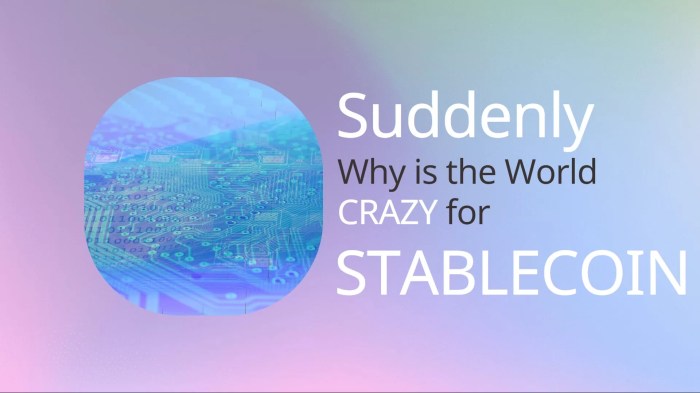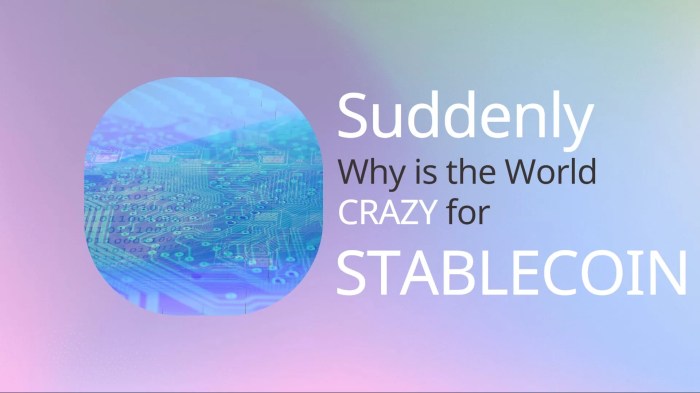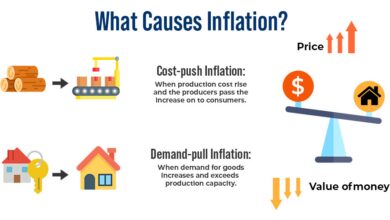
Why Are Stablecoins So Famous?
Why are stablecoins so famous? In a world where cryptocurrencies are known for their volatility, stablecoins stand out as a beacon of stability. These digital assets are designed to maintain a consistent value, typically pegged to a fiat currency like the US dollar.
This makes them an attractive alternative to traditional currencies and volatile cryptocurrencies, offering a unique blend of digital convenience and predictable value.
Stablecoins have gained significant traction in recent years, finding their way into various applications, from everyday payments to complex DeFi protocols. But what exactly makes them so popular? Let’s dive into the reasons behind the rise of stablecoins and explore their potential impact on the future of finance.
Stablecoins

Stablecoins are a type of cryptocurrency designed to maintain a stable value, typically pegged to a fiat currency like the US dollar or a commodity like gold. They aim to mitigate the price volatility inherent in traditional cryptocurrencies like Bitcoin, making them more suitable for everyday transactions and use cases.
Types of Stablecoins
Stablecoins are classified based on their underlying mechanisms and backing assets. Here are the main types:
- Fiat-backed stablecoins: These are the most common type. They are backed by reserves of fiat currency held in a bank account or a similar secure location. Each stablecoin issued represents a claim on a specific amount of the underlying fiat currency.
Stablecoins are popular because they offer a bridge between the volatile world of cryptocurrencies and the stability of traditional fiat currencies. But this stability can also be exploited, as we’ve seen with the rise of pandemic fraud. Prosecutors are struggling to catch up to a tidal wave of pandemic fraud , which has often involved the use of stablecoins to launder stolen funds.
This highlights the importance of regulatory oversight and security measures in the stablecoin space, as the technology continues to gain mainstream adoption.
For example, Tether (USDT) is a fiat-backed stablecoin pegged to the US dollar, meaning each USDT is supposed to be backed by one US dollar held in reserve.
- Crypto-backed stablecoins: These stablecoins are backed by other cryptocurrencies, typically a more established and stable cryptocurrency like Bitcoin or Ethereum. The value of the stablecoin is pegged to the price of the underlying cryptocurrency. For example, Dai (DAI) is a crypto-backed stablecoin pegged to the US dollar, where its value is maintained through a system of smart contracts and collateralized loans.
- Algorithmic stablecoins: These stablecoins use algorithms and smart contracts to maintain their peg to a target asset. They typically rely on a combination of mechanisms, such as minting and burning stablecoins, to adjust supply and demand based on market fluctuations.
For example, TerraUSD (UST) was an algorithmic stablecoin pegged to the US dollar, using a complex system of arbitrage and incentives to maintain its stability.
Popular Stablecoins and Their Backing Assets
Here is a table listing some of the most popular stablecoins and their respective backing assets:
| Stablecoin | Backing Asset | Type |
|---|---|---|
| Tether (USDT) | US Dollar | Fiat-backed |
| USD Coin (USDC) | US Dollar | Fiat-backed |
| Binance USD (BUSD) | US Dollar | Fiat-backed |
| Dai (DAI) | Ethereum (ETH) | Crypto-backed |
| TrueUSD (TUSD) | US Dollar | Fiat-backed |
Advantages of Stablecoins
Stablecoins have emerged as a significant force in the cryptocurrency landscape, offering a unique blend of digital asset characteristics and traditional financial stability. Their popularity stems from several key advantages that address the inherent challenges of traditional currencies and volatile cryptocurrencies.
Stablecoins are famous for their price stability, offering a haven in the volatile world of cryptocurrencies. This makes them attractive for everyday transactions, just like the innovative approach of the NHS using drones to fly blood samples around London, as reported by this recent news article , to bypass traffic congestion and ensure faster delivery of vital samples.
This focus on efficiency and reliability, mirrored in the stablecoin space, is driving the growing popularity of these digital assets.
Price Stability
Price stability is a cornerstone of stablecoins’ appeal. Unlike volatile cryptocurrencies like Bitcoin and Ethereum, which can experience dramatic price swings, stablecoins are designed to maintain a relatively stable value. This stability is typically achieved through various mechanisms, such as pegging to a fiat currency like the US dollar or backing by a basket of assets.
Reduced Volatility
The inherent volatility of cryptocurrencies has long been a barrier to mainstream adoption. Stablecoins, by their very nature, offer a solution to this challenge. Their price stability provides a much-needed haven for investors and traders seeking to mitigate risk and protect their assets from market fluctuations.
Ease of Use
Stablecoins are designed for user-friendliness. Their integration with existing financial systems and the ease of their use within decentralized applications (dApps) make them a convenient and accessible option for a wide range of users.
Stablecoins are famous for their price stability, making them a popular choice for investors and traders looking to hedge against volatility. But while the crypto world buzzes with the latest trends, it’s refreshing to see real-world news like Hawaii Lt.
Gov. Josh Green winning the Democratic primary for governor. It’s a reminder that even in a world of decentralized finance, the power of democracy and human connection still holds sway. And, just like stablecoins provide a safe haven in the crypto market, a strong political leader can provide stability and direction in our ever-changing world.
Facilitating Cross-Border Payments and Remittances, Why are stablecoins so famous
Stablecoins are transforming the landscape of international payments and remittances. Their ability to bypass traditional banking systems, which can be slow and expensive, allows for faster and more cost-effective transactions across borders.
Examples of Stablecoin Use Cases
Stablecoins are being utilized in a growing number of real-world applications. Here are some notable examples:
- Payment Processing:Stablecoins are increasingly being used as a means of payment for goods and services, both online and offline. This is particularly attractive in regions where traditional payment methods are limited or expensive.
- Micropayments:Stablecoins’ low transaction fees make them ideal for facilitating micropayments, enabling seamless and cost-effective transactions for small amounts of money.
- Decentralized Finance (DeFi):Stablecoins play a pivotal role in DeFi protocols, providing a stable foundation for lending, borrowing, and other financial applications.
Stablecoins in Decentralized Finance (DeFi)
Stablecoins are a vital component of the Decentralized Finance (DeFi) ecosystem, playing a crucial role in enabling a wide range of financial applications and services on blockchain networks.
The Role of Stablecoins in DeFi
Stablecoins are essential for DeFi applications because they mitigate the volatility inherent in cryptocurrencies. Their price stability allows users to conduct financial transactions and build financial products without the risk of significant price fluctuations.
Examples of DeFi Protocols Utilizing Stablecoins
- Lending and Borrowing:Platforms like Aave, Compound, and MakerDAO allow users to lend and borrow crypto assets, often using stablecoins as collateral. This enables users to access liquidity and earn interest on their holdings while maintaining a stable value. For example, users can deposit USDC as collateral to borrow ETH, benefiting from the potential for ETH price appreciation while minimizing the risk of losing their principal due to price volatility.
- Decentralized Exchanges (DEXs):Stablecoins facilitate trading on DEXs like Uniswap and Curve Finance, providing a stable base for trading pairs and reducing slippage. For instance, traders can swap ETH for USDC, a stablecoin, to avoid potential losses from ETH’s price fluctuations during the transaction.
- Yield Farming:Stablecoins are widely used in yield farming strategies, where users deposit their assets into liquidity pools to earn rewards. Stablecoins offer a stable return on investment compared to volatile cryptocurrencies, making them attractive for yield farming.
Impact of Stablecoins on the DeFi Ecosystem
Stablecoins have significantly impacted the growth and adoption of DeFi by:
- Increased Liquidity:Stablecoins have brought more liquidity to DeFi protocols, allowing users to access funds and trade assets more efficiently.
- Reduced Volatility:By mitigating price fluctuations, stablecoins have created a more stable and predictable environment for DeFi applications.
- New Financial Products:Stablecoins have enabled the development of innovative financial products, such as synthetic assets, decentralized insurance, and stablecoin-based derivatives.
Risks and Challenges Associated with Stablecoins: Why Are Stablecoins So Famous
While stablecoins offer numerous advantages, they also come with inherent risks and challenges that require careful consideration. These risks can stem from regulatory uncertainty, market manipulation, and security vulnerabilities, among other factors.
Regulatory Uncertainty
The regulatory landscape surrounding stablecoins is still evolving, leading to uncertainty for both issuers and users. This uncertainty can hinder innovation and growth in the stablecoin ecosystem.
- Lack of Clear Regulations:Many jurisdictions lack clear regulations governing stablecoin issuance, operation, and consumer protection. This ambiguity can create legal and compliance challenges for stablecoin issuers, potentially discouraging them from entering the market.
- Varying Regulatory Approaches:Different jurisdictions have adopted varying regulatory approaches, making it challenging for stablecoin issuers to comply with a patchwork of rules. This can lead to fragmentation in the market and hinder the development of a unified regulatory framework.
- Potential for Regulatory Overreach:Concerns exist that overregulation could stifle innovation and stifle the growth of the stablecoin ecosystem. Striking a balance between consumer protection and fostering innovation is crucial.
Market Manipulation
The potential for market manipulation is a significant concern in the stablecoin space. This can occur through various means, including:
- Artificial Price Inflation:Malicious actors could artificially inflate the price of a stablecoin, leading to unsustainable growth and potential market crashes.
- De-pegging Events:Manipulating the price of a stablecoin can lead to de-pegging events, where the stablecoin loses its peg to the underlying asset, resulting in significant losses for investors.
- Flash Loan Attacks:Flash loans can be used to manipulate the price of stablecoins by borrowing large sums of money and using them to buy or sell the stablecoin, causing artificial price fluctuations.
Security Vulnerabilities
Stablecoin systems are not immune to security vulnerabilities, which can expose them to hacks, theft, and other security breaches.
- Smart Contract Vulnerabilities:Stablecoins often rely on smart contracts, which can be susceptible to vulnerabilities that could allow attackers to drain funds or manipulate the system.
- Centralized Points of Failure:Some stablecoins rely on centralized entities for their operation, which can create single points of failure that attackers can exploit.
- Data Breaches:Stablecoin issuers need to protect sensitive user data from breaches, as unauthorized access to this data could lead to identity theft or other forms of financial fraud.
Maintaining Price Stability and Transparency
Maintaining price stability and transparency is crucial for the success of stablecoins.
- Algorithmic Stability:Algorithmic stablecoins aim to maintain price stability through automated mechanisms, but these mechanisms can be complex and prone to failure.
- Transparency of Reserves:Stablecoins backed by assets should provide transparent information about their reserves to ensure that the stablecoin is adequately collateralized and can maintain its peg.
- Auditing and Verification:Regular audits and verification processes are essential to ensure the accuracy and integrity of stablecoin systems.
Impact of De-pegging Events
De-pegging events, where a stablecoin loses its peg to the underlying asset, can have a significant impact on the stability and reputation of stablecoins.
- Loss of Investor Confidence:De-pegging events can erode investor confidence in stablecoins, leading to market volatility and potential price crashes.
- Reputation Damage:De-pegging events can damage the reputation of stablecoins, making it harder for them to attract new investors and maintain their value.
- Systemic Risk:In some cases, de-pegging events can lead to systemic risk, where the failure of one stablecoin can trigger a cascade of failures across the entire stablecoin ecosystem.
The Future of Stablecoins
The world of stablecoins is rapidly evolving, with new innovations and advancements constantly emerging. As these digital assets continue to gain traction, their potential impact on the financial landscape becomes increasingly significant. We will explore the potential future of stablecoins, their role in the broader economy, and the innovations that are shaping this dynamic space.
Impact on Traditional Financial Institutions
Stablecoins have the potential to disrupt traditional financial institutions by offering faster, cheaper, and more accessible alternatives to traditional financial services.
- Increased Competition:Stablecoins can provide a more efficient and cost-effective way to transfer value, potentially challenging the dominance of traditional financial institutions in areas such as payments and remittances.
- New Opportunities:Stablecoins can also open up new opportunities for financial institutions, allowing them to tap into the growing DeFi ecosystem and offer innovative financial products and services.
- Collaboration and Integration:The future may see a greater degree of collaboration between traditional financial institutions and stablecoin providers, leading to the development of hybrid financial products and services that leverage the benefits of both worlds.
Advancements and Innovations in the Stablecoin Space
The stablecoin space is characterized by continuous innovation and the emergence of new technologies.
- Decentralized Stablecoins:The development of decentralized stablecoins, which rely on algorithmic mechanisms to maintain price stability, is a significant trend. These stablecoins aim to reduce reliance on centralized entities and promote greater transparency and security.
- Interoperability and Cross-Chain Compatibility:Efforts are underway to enhance interoperability between different stablecoin platforms, allowing for seamless transfers of value across blockchains.
- Real-World Applications:Stablecoins are finding increasing use cases beyond the realm of cryptocurrencies, with applications in areas such as supply chain finance, payments, and microfinance.






